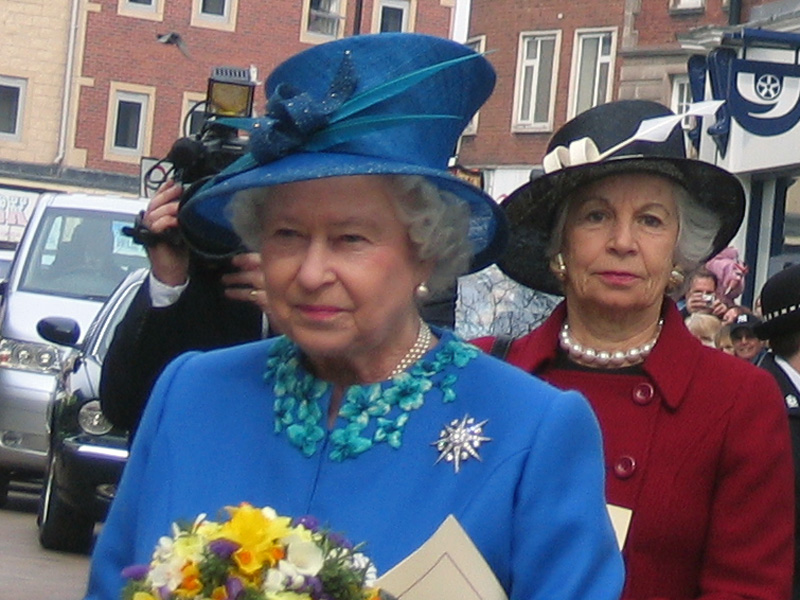|
Varvara Michajlovna Arsen'eva
Varvara Mikhailovna Arsenyeva (Russian: Варва́ра Миха́йловна Арсе́ньева; 1676–1730), was a Russian courtier and mistress of Peter the Great. Biography She was the daughter of the yakut Governor Mikhail Afanasyevich Arsenyev. Her sister Daria married Alexander Danilovich Menshikov in 1706. She was appointed lady in waiting to the Empress Catherine, and was for a time the lover of Peter the Great. In 1727, she was appointed Ober-Hofmeisterin to her niece Maria Menshikova, daughter of her sister Daria, who was bethrothed to Grand Duke Peter of Russia. The same year, however, she was exiled to the Alexandrov Kremlin after the fall of Menshikov. Wishing to be released from captivity, Varvara sent gifts and wrote to the Grand Duchesses Ekaterina and Praskovya, Princess Tatiana Kirillovna Golitsyna, M. M. Rzhevskaya, and other influential ladies of the time, but it was in vain. A year later, the position of the Menshikov's worsened, and it was decided ... [...More Info...] [...Related Items...] OR: [Wikipedia] [Google] [Baidu] |
Lady-in-Waiting
A lady-in-waiting (alternatively written lady in waiting) or court lady is a female personal assistant at a Royal court, court, attending on a royal woman or a high-ranking nobility, noblewoman. Historically, in Europe, a lady-in-waiting was often a noblewoman but of lower rank than the woman to whom she attended. Although she may either have received a Retainer agreement, retainer or may not have received compensation for the service she rendered, a lady-in-waiting was considered more of a personal assistant, secretary, courtier, or Lady's companion, companion to her Mistress (form of address), mistress than a domestic worker, servant. In some other parts of the world, the lady-in-waiting, often referred to as ''palace woman'', was in practice a servant or a slave rather than a high-ranking woman, but still had about the same tasks, functioning as companion and secretary to her mistress. In courts where polygamy was practiced, a court lady might have been formally available to ... [...More Info...] [...Related Items...] OR: [Wikipedia] [Google] [Baidu] |
Goritsky Monastery (Goritsy)
The Goritsy Monastery of Resurrection () is a Russian Orthodox convent (female monastery) in the village of Goritsy, Kirillovsky District, Vologda oblast, Russia. The convent is north of the town of Kirillov, Kirillovsky District, which was the site of one of the historically most important (as well as wealthiest) male monasteries in Russia, and to which Tsar Ivan the Terrible, discussed below, had planned to retire.Goritsky Monastery Since the 1970s, the Kirillo-Belozerksy museum zapovedni ... [...More Info...] [...Related Items...] OR: [Wikipedia] [Google] [Baidu] |
Ladies-in-waiting Of The Tsardom Of Russia
A lady-in-waiting (alternatively written lady in waiting) or court lady is a female personal assistant at a court, attending on a royal woman or a high-ranking noblewoman. Historically, in Europe, a lady-in-waiting was often a noblewoman but of lower rank than the woman to whom she attended. Although she may either have received a retainer or may not have received compensation for the service she rendered, a lady-in-waiting was considered more of a secretary, courtier, or companion to her mistress than a servant. In some other parts of the world, the lady-in-waiting, often referred to as ''palace woman'', was in practice a servant or a slave rather than a high-ranking woman, but still had about the same tasks, functioning as companion and secretary to her mistress. In courts where polygamy was practiced, a court lady might have been formally available to the monarch for sexual services, and she could become his wife, consort, courtesan, or concubine. ''Lady-in-waiting'' or '' ... [...More Info...] [...Related Items...] OR: [Wikipedia] [Google] [Baidu] |
Mistresses Of Peter The Great
Mistress is the feminine form of the English word "master" (''master'' + ''-ess'') and may refer to: Romance and relationships * Mistress (lover), a female lover of a married man ** Royal mistress * Maîtresse-en-titre, official mistress of a French king Title or form of address * Mistress (form of address) * Mistress (college), a female college head * Mistress of the Robes of the UK Royal Household * Female equivalent of schoolmaster In ancient religions * Despoina, a Greek goddess referred to as "the mistress" * Potnia ("mistress lady"), a title for a Greek goddess In arts and entertainment * Mistress (band), a band from Birmingham, England * ''Mistress'', a band from Germany, fronted by Angela Gossow * ''Mistress'' (1992 film) * ''Mistress'' (1987 film) * ''Mistresses'' (British TV series) * ''Mistresses'' (American TV series) * ''Mistress'' (TV series) * "Mistress", a song by Disturbed from ''Believe'' * "Mistress", a song by Rebecca Ferguson from ''Superwoman'' * ... [...More Info...] [...Related Items...] OR: [Wikipedia] [Google] [Baidu] |
18th-century People From The Russian Empire
The 18th century lasted from 1 January 1701 (represented by the Roman numerals MDCCI) to 31 December 1800 (MDCCC). During the 18th century, elements of Enlightenment thinking culminated in the Atlantic Revolutions. Revolutions began to challenge the legitimacy of monarchical and aristocratic power structures. The Industrial Revolution began mid-century, leading to radical changes in human society and the environment. The European colonization of the Americas and other parts of the world intensified and associated mass migrations of people grew in size as part of the Age of Sail. During the century, slave trading expanded across the shores of the Atlantic Ocean, while declining in Russia and China. Western historians have occasionally defined the 18th century otherwise for the purposes of their work. For example, the "short" 18th century may be defined as 1715–1789, denoting the period of time between the death of Louis XIV of France and the start of the French Revolution, ... [...More Info...] [...Related Items...] OR: [Wikipedia] [Google] [Baidu] |
1730 Deaths
Events January–March * January 30 (January 19 O.S.) – At dawn, Emperor Peter II of Russia dies of smallpox, aged 14 in Moscow, on the eve of his projected marriage. * February 26 (February 15 O.S.) – Anna of Russia (Anna Ioannovna) becomes reigning Empress of Russia following the death of her cousin Emperor Peter II. * February 28 – Vitus Bering returns to the Russian capital of Saint Petersburg after completing the First Kamchatka expedition. * March 5 – The 1730 papal conclave to elect a new Pope for the Roman Catholic church begins with 30 Cardinals, 12 days after the death of Pope Benedict XIII. By the time his successor is elected on July 12, there are 56 Cardinals. * March 9 – General Nader Khan of Persia opens the first campaign of the Ottoman–Persian War (1730–1735), guiding the Persian Army from Shiraz and starting the Western Persia Campaign against the Ottoman Empire. * March 12 – John Glas is deposed ... [...More Info...] [...Related Items...] OR: [Wikipedia] [Google] [Baidu] |
1676 Births
Events January–March * January 29 – Feodor III of Russia, Feodor III becomes Tsar of Russia. * January 31 – Universidad de San Carlos de Guatemala, the oldest institution of higher education in Central America, is founded. * January – Six months into King Philip's War, Metacomet (King Philip), leader of the Algonquian peoples, Algonquian tribe known as the Wampanoag people, Wampanoag, travels westward to the Mohawk nation, seeking an alliance with the Mohawks against the Colonial history of the United States, English colonists of New England; his efforts in creating such an alliance are a failure. * February 10 – After the Nipmuc tribe attacks Lancaster, Massachusetts, colonist Mary Rowlandson is taken captive, and lives with the Indians until May. * February 14 – Metacomet and his Wampanoags attack Northampton, Massachusetts; meanwhile, the Massachusetts Council debates whether a wall should be erected around Boston. * February 23 & ... [...More Info...] [...Related Items...] OR: [Wikipedia] [Google] [Baidu] |
Lady-in-waiting Of The Imperial Court Of Russia
A lady-in-waiting of the Imperial Russian Court (''придворные дамы'') was a woman of high aristocracy at the service of a woman of the Imperial family. They were organised according to the strict hierarchy of Peter the Great's table of ranks, following the woman's ''chin'' (rank) established on January 24, 1722. Definition and table of ranks All the ancient occupations of the women at the Court of Russia, traditionally held by ''boyarynias'' (wives of ''boyars''), nurses, housekeepers, servants, nannies etc., were abolished and replaced by a new hierarchy inspired by Versailles Court's etiquette and German models, although many Muscovite and post-reform positions were in charge of identical functions. The new hierarchy used German terminology. * Ober-Hofmeisterin (The Great Mistress of the Court); first class *Wives of members of the Privy council of Russia; second class *Deystvitelnaya Statsdame (literally Acting Lady of the State); third class *Deystvitelnay ... [...More Info...] [...Related Items...] OR: [Wikipedia] [Google] [Baidu] |
Order Of Saint Catherine
The Imperial Order of Saint Catherine () was an award of Imperial Russia. Instituted on 24 November 1714 by Peter the Great on the occasion of his marriage to Catherine I of Russia. For the majority of the time of Imperial Russia, it was the only award for women; the Insignia of Saint Olga existed briefly from 1916 to 1917, but ceased with the fall of the Romanov dynasty. The statutes of the Order were first published in 1713, and the order was under the patronage of Saint Catherine of Alexandria, the patron saint of the Empress. On 24 November 1714, on the Empress' name day, Peter the Great personally bestowed the insignia of the Order upon the Empress Catherine, creating her Grand Mistress of the Order. However, no further members were inducted until 1726. Today, Grand Duchess Maria Vladimirovna is acknowledged as Grand Mistress of the Order by Burke's World Orders of Knightood and Merit, and by the International Commission on Orders of Chivalry. This right is disputed by s ... [...More Info...] [...Related Items...] OR: [Wikipedia] [Google] [Baidu] |
Beryozovo, Khanty-Mansi Autonomous Okrug
Beryozovo (; Khanty: Сўмт вош, ''Sŭmt-voš''; Mansi: Ха̄льӯс, ''Hāļūs'') is an urban locality (an urban-type settlement) and the administrative center of Beryozovsky District of Khanty-Mansi Autonomous Okrug, Russia, located on the Ob River. Population: Geography It is situated on three hills on the left bank of the Severnaya Sosva River, at its junction with the Ob River. It has more than once suffered from conflagrations, including fires in 1719 and 1808. The yearly mean temperature is , with the low being . History Some ill-documented Russian trade took place in the area before the Russian conquest of Siberia. Beryozovo was founded in 1593 on the Severnaya Sosva route across the Ural Mountains to the fur-rich Mangazeya region. Ostyaks besieged the settlement in 1592, 1697, and 1608. It grew into a town of Beryozov () in Tobolsk Governorate. By the late 17th century most trade had shifted south to Verkhoturye. Prince Menshikov, the favorite of Peter ... [...More Info...] [...Related Items...] OR: [Wikipedia] [Google] [Baidu] |
Catherine I Of Russia
Catherine I Alekseyevna Mikhailova (born Marta Samuilovna Skavronskaya; – ) was the second wife and Empress consort of Peter the Great, whom she succeeded as Empress of Russia, ruling from 1725 until her death in 1727. Life as a servant Only uncertain and contradictory information is available about her early life. Said to have been born on 15 April 1684 ( o.s. 5 April), she was originally named Marta Helena Skowrońska. Marta was the daughter of Samuel Skowroński (also spelled ''Samuil Skavronsky''), a Roman Catholic farmer from the eastern parts of the former Polish–Lithuanian Commonwealth, his parents were born in the area of Minsk (now Belarus). In 1680, he married Dorothea Hahn at Jakobstadt (now Jēkabpils, Latvia). Her mother is named in at least one source as Elizabeth Moritz, a daughter of a Baltic German woman, and there is debate as to whether Moritz's father was a Swedish officer. It is likely that two stories were conflated, and Swedish sources suggest that t ... [...More Info...] [...Related Items...] OR: [Wikipedia] [Google] [Baidu] |





